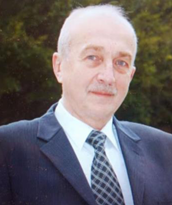Investigation of the structure of shock waves in loose and monolithic andesite by laser interferometry
https://doi.org/10.18384/2949-5067-2025-2-55-65
Abstract
Aim is to characterize andesite, a volcanic mineral similar in structure and chemical composition to lunar regolith, under shock compression conditions at loading speeds of up to 800 m/s.
Methodology. Flat andesite samples were subjected to a one-dimensional impact by a striker accelerated in a pneumatic throwing device. The laser Doppler interferometry method was used to measure the velocity profiles of the free surface of the samples when a shock compression wave was released onto it in the pressure range from 0.5 to 1.9 GPa. The time of compression wave passage in samples of a given thickness was measured.
Results. For the first time, Hugoniot adiabats were obtained for bulk samples (with an average grain size of (80–90) microns, with grain sizes from 400 microns to several hundred nanometers) and monolithic andesite at relatively low impact velocities from 250 to 800 m/s. The surface velocity profiles at the ‘sample – diagnostic window’ boundary at the moment of the shock compression wave exit were obtained. A comparison with the Martian regolith analogue was made. It has been found that at mass velocities less than 350 m/s, a region of adiabatic compression occurs, in which only deformation of the substance without phase transitions in it takes place. At a pressure of 1.9 GPa, an elastic precursor was detected, which is typical for the region of elastic deformation.
Research implications. The results obtained are important for the development of engineering and numerical models of the properties of lunar soils in the interaction of landers with them in upcoming expeditions.
Keywords
About the Authors
V. S. ZiborovRussian Federation
Vadim S. Ziborov – Cand. Sci. (Phys.-Math.), Senior Researcher; Laboratory No. 6.2. – Shock Wave Effects
Moscow
T. A. Rostilov
Russian Federation
Timofei A. Rostilov – Cand. Sci. (Phys.-Math.), Research Assistant, Laboratory No. 6.2. – Shock Wave Effects
Moscow
G. G. Dolnikov
Russian Federation
Gennadiy Gen. Dolnikov – Cand. Sci. (Phys.-Math.), Leading Engineer, Department of Physics of Planets and Small Bodies of the Solar System
Moscow
References
1. Ignatova, A. M. & Ignatov, M. N. (2013). Use of resources for regolith exploration of the lunar surface. In: International Journal of Experimental Education, 11-2, 101–110 (in Russ.).
2. Lomonosov, I, V. (2024). Equatons of state for regolith and chondrite at high pressure. In: Doklady Physics, 515 (1), 9–12. DOI: 10.31857/S2686740024020023 (in Russ.).
3. Li, Ruilin, Zhou, Guoqing, Yan, Kang, Chen, Jun, Chen, Daqing, Cai, Shangyue & Mo, Pin-Qiang (2022). Preparation and characterization of a specialized lunar regolith simulant for use in lunar low gravity simulation. In: International Journal of Mining Science and Technology, 32 (1), 1–15. DOI: 10.1016/j.ijmst.2021.09.003.
4. Hubbard, N. J. Nyquist, E. N., Rhodes, J. M., Bansal, B. M., Wiesmann, H. & Church, S. E. (1972). Chemical features of the Luna 16 regolith sample. In: Earth and Planetary Science Letters, 13 (2), 423–428. DOI: 10.1016/0012-821X(72)90119-7.
5. Ziborov, V. S., Kanel’, G. I. & Rostilov, T. A. (2020). Experimental Study of deformation of spheroplastics under shock compression. In: Combustion, Explosion and Shock Waves, 56 (2), 124–129. DOI: 10.15372/FGV20200215 (in Russ.).
6. Barker, L. M. & Hollenbach, R. E. (1972). Laser interferometer for measuring high velocities of any reflecting surface. In: Journal of Applied Physics, 43 (11), 4669–4675. DOI: 10.1063/1.1660986.
7. Medvedev, A. B. & Trunin, R. F. (2012). Shock compression of porous metals and silicates. In: Physics-Uspekhi (Advances in Physical Sciences), 182 (8), 829–846. DOI: 10.3367/UFNr.0182.201208b.0829 (in Russ.).
8. Rostilov, T., Ziborov, V., Dolgoborodov, A. & Kuskov, M. (2024). Effect of porosity on rapid dynamic compaction of nickel nanopowder. In: Physical Chemistry Chemical Physics, 26 (2), 848–855. DOI: 10.1039/D3CP04985J.
9. Ahrens, T. J. & Johnson, M. L. (1995). Shock Wave Data for Minerals. In: Ahrens, T. J. (ed.). Mineral Physics & Crystallography: A Handbook of Physical Constants. Vol. 2. Washington DC: American Geophysical Union, pp. 143–184 (Series: AGU Reference Shelf). DOI: 10.1029/RF002p0143.
10. Ziborov, V., Rostilov, T., Kronrod, E., Kuznetsov, Il. & Dolnikov G. (2024). Impact response of physical analog of Martian regolith. In: International Journal of Impact Engineering, 188, article no. 104949. DOI: 10.1016/j.ijimpeng.2024.104949.
11. Ahrens, T. J. & Cole, D. M. (1974). Shock compression and adiabatic release of lunar fines from Apollo 17. In: Proceedings of Fifth Lunar Science Conference (Houston, Tex., March 18-22, 1974). Vol. 3. New York: Pergamon Press, Inc., pp. 2333–2345.
12. Ahrens, T. J. (1975). Compaction by impact of unconsolidated lunar fines. In: Moon, 14, 291–299.

































